
In the age of COVID-19 — of work-from-home quarantines, sweatpants, and Facetime cocktails — Mostafa Maklad’s routine is largely the same.
His day begins in a 2-bedroom Daly City, California apartment he shares with 6 other Uber drivers. He drinks a cup of coffee and wipes down his silver SUV. By 10 am, he’s trawling the streets of San Francisco, waiting for the ‘ping’ of a new ride request.
On a good day, it’s a tough business. On a day in the middle of a global pandemic, it’s a fight to survive.
Before coronavirus shut down the city’s offices, schools, and restaurants, Maklad would give around 40 rides during a 12-hour shift. Now, he struggles to find 15. More than 10 hours into his shift on a recent Thursday night, he’s grossed $65, pre-expenses.
“I’ll stop when I hit $100,” he texts us at 8 pm. “Maybe another 3 or 4 hours.”
For Maklad, and thousands of other drivers who rely on rideshare apps for full-time work, income has decreased by more than 60% in recent weeks.
With minimal support from the platforms they serve, drivers like Maklad have faced a Catch-22: Stay home and sacrifice a livelihood, or keep driving in a depressed market and risk contracting the virus.
To better understand the hardship of this decision, The Hustle spoke with more than 50 full-time rideshare drivers by phone, email, and text.
No choice but to drive
Maklad is one of more than 1m active Uber and Lyft drivers in the US.
For most, it’s a side hustle. But roughly 20% of drivers rely on ridesharing services as a sole source of income, sometimes driving up to 80 hours per week.
Maklad’s path into this work began 6 years ago, when he fled Egypt and found asylum in the US. After struggling to find full-time work, he was enticed by an Uber ad that told him he could have flexible hours and “be his own boss.”
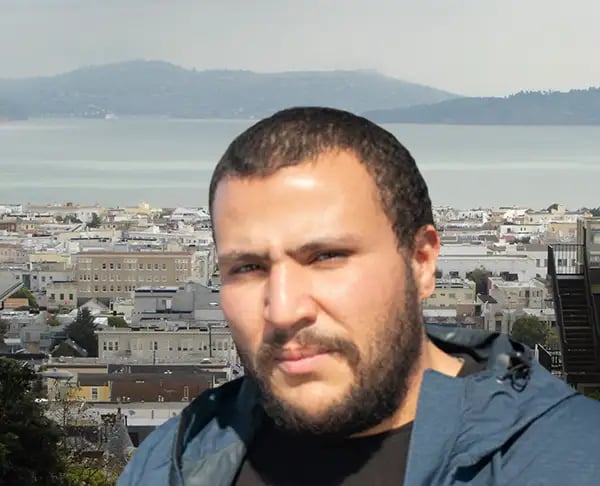
Mostafa Maklad has continued to work through coronavirus — but his earnings have plunged by 60% (Via GWR/Mostafa Maklad)
As independent contractors, rideshare drivers don’t receive sick leave, unemployment insurance, or the many other benefits enjoyed by W-2 employees.
During a pandemic, this has proven to be especially problematic.
Many cities have imposed shelter-in-place ordinances, barring residents from any “nonessential” out-of-home activities for the next 3 weeks. The social hotspots are temporarily shuttered. Office workers are shelled up in their bedrooms with video conferencing software. Once-bustling metropolises are eerily post-apocalyptic.
Deemed “essential” workers, Uber and Lyft drivers have been encouraged to continue business as usual.
But the current state of affairs has polarized drivers: In a survey of nearly 400 full-time Uber and Lyft drivers The Hustle conducted last week, 57% said they will continue to work at the peril of their health, while 43% have decided to stay home and sacrifice their sole source of income.
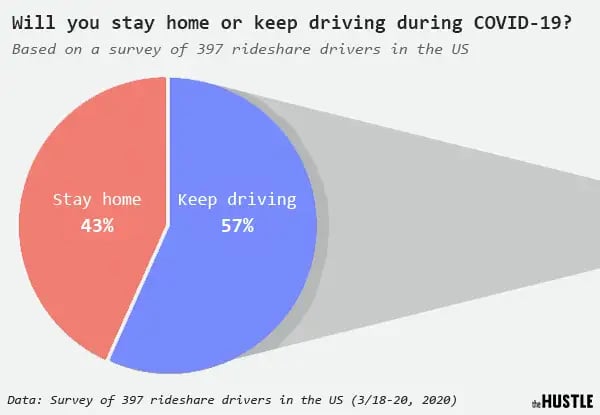
Zachary Crockett / The Hustle
Many drivers told us that, while aware of the inherent exposure risks in carting strangers around in an enclosed metal box all day, they have no choice but to work:
- Junaid Awan (Charlotte, NC): “I have a 6-month-old daughter, a family, and apartment rent on my head. I have bills to pay. I’ve been making about $40 a day since last Monday.”
- Virginia Arellano (Woodlands, TX): “I have no money for rent or utilities. I am the sole provider of my 8-year-old son. I don’t feel safe driving, but I have to pay bills and take care of my son.”
- Cindy Chavez (Bloomington, IN): “I have 3 children at home and a husband. We are behind on our bills and have little food.”
- Mike Capicato (Orange County, CA): “My family is facing default, eviction, and bankruptcy. I have no choice but to drive.”
- Cheryl Danylchuk (Dallas, TX): “I have a sister that has cancer. I am her caregiver and have taken care of her for most of her life. I wish I didn’t have to drive. My worst fear is bringing home the virus to her.”
For those still braving the streets, the work is slim.
Data gathered from 58 full-time drivers by The Hustle showed a dramatic decline across a number of metrics in recent weeks, including average number of rides per day (23 → 6), weekly pay ($1,072 → $348), and hourly pay ($22 → $9).
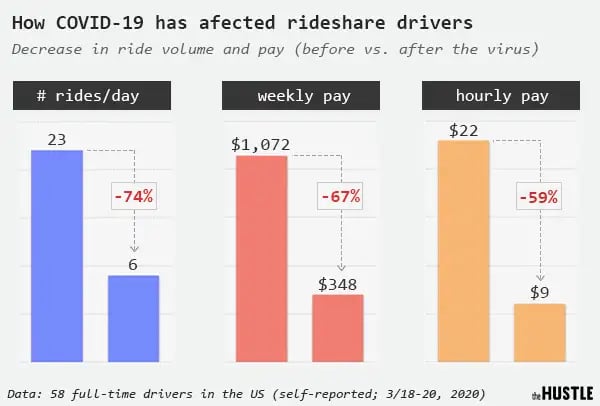
Zachary Crockett / The Hustle
In the months before COVID-19, the drivers in our sample averaged $22/hr. Last week, these same drivers earned just $9/hr.. After accounting for work-related expenses and platform fees, this drops down to around $5.50/hr — less than the federal minimum wage.
The income generated from ridesharing is highly variable. But nearly every driver in our survey reported deflated ride volume. Some claim to have gone from 30 rides per day down to only 3 or 4 spread across a 10-hour shift.
The lack of passengers, coupled with slightly decreased working hours (48 → 38, on average) has, in many cases, led to massive and catastrophic cuts in income.
Average hourly pay (based on daily fares and number of hours worked, pre-expenses) dropped between 22% and 85% among the drivers we surveyed. Those in California, which recently enacted the nation’s “strictest” state lockdown, have been hit especially hard.
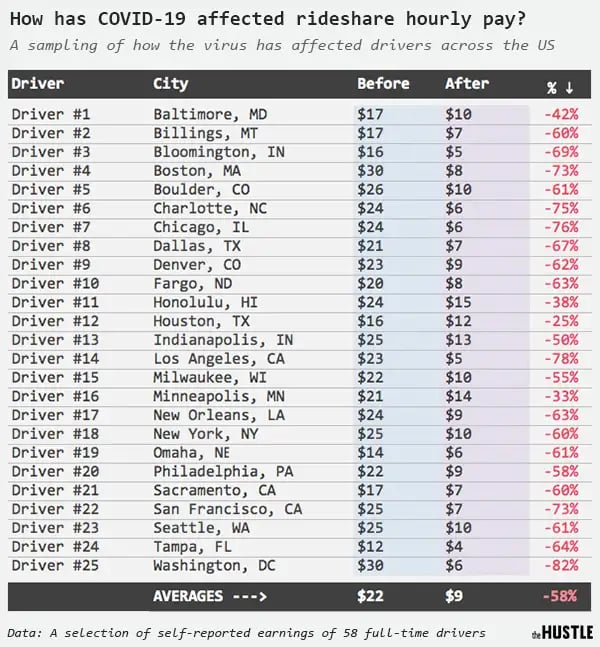
A selection of individual reports from our survey (Zachary Crockett / The Hustle)
(Note: Several drivers in this story wished to withhold their last name, or remain anonymous, for fear of retaliation from the rideshare platforms.)
Melvin G., a Lyft driver in Los Angeles, typically brings in $600 to $800 per week. Last week, driving the same number of hours, he struggled to make $100.
Like many rideshare drivers we talked to, Melvin rents his car through Hertz, a Lyft-affiliated agency. His earnings last week were less than half of the $244.95 weekly rental payment he’s required to pay out of his share.
“I’m not even breaking even,” he says. “I’m deep in the hole.”
Amirali Alex F., 32, has been driving in San Francisco for 2.5 years. His income goes toward medical bills for his 64-year-old mother, who was recently diagnosed with breast cancer.
In a typical week, he says he drives 45 hours and makes $1.2k. Last week, he drove the same number of hours — and traversed 900 miles all over the Bay Area — just to make $300. After gas, tolls, and food, he was left with less than half of that.
“This virus ain’t no joke but we got bills to pay,” Rosa S., of Charlotte, NC, told us on Thursday morning, before heading out on the job. Later that evening, the recent grandmother texted an update: “Been out 7.5 hours today, only got 2 rides.”
By day’s end, she’d made $50.46 — around $30 after expenses.
Corona nightmares
The need to pay the bills has dramatically increased drivers’ risk of contracting COVID-19, a highly contagious, airborne virus.
“I’ve literally been driving people to the hospital,” one New York City driver, who wished to remain anonymous, told us between rides. “I had one guy get into my car who was hacking for 10 minutes straight. I pulled over and cleaned my car for 20 minutes after.”
On March 8, a 33-year-old Uber driver who served the Long Island, New York, area tested positive for the virus. Though Uber and Lyft suspended shared rides, health concerns continue to linger, both for drivers and the passengers they serve.
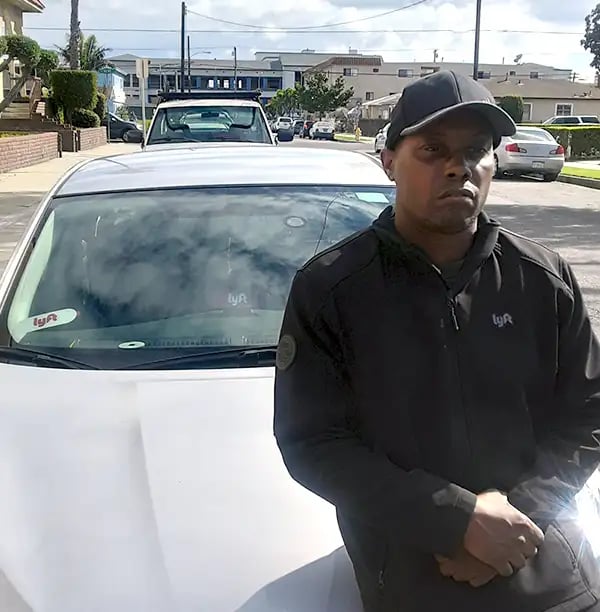
Melvin G., a Lyft driver in Los Angeles, has seen his income drop from $800 to $100 per week (Courtesy of Melvin G.)
“They are vectors for this disease,” Veena Dubal, a professor of law at UC Hastings, says of the drivers. “And they have no training in health and safety.”
In early March, Uber and Lyft pledged to do their best to provide drivers with basic sanitation products like hand sanitizer and wipes. But the companies have struggled to find supplies during a global shortage and have since closed down the driver hubs where they were meant to be dispensed. (Uber and Lyft told us they are actively working to change this.)
Many drivers we spoke with have turned to fellow drivers for help, using WhatsApp groups to swap Lysol cans, gloves, and masks.
The fear of exposure has caused drivers like Yash Bazian, a 48-year-old who does the bulk of his driving in the San Francisco Bay Area, undue psychological stress. He’s been having nightmares about coronavirus.
“I could catch the virus from anyone,” he says by phone, 9 hours and $50 into a recent Friday night. “Today I sat thinking, ‘Should I work or not? Should I work or not?’”
For others, the answer is clear: Avoid exposure at all costs — even if the decision comes with severe financial repercussions.
Calling in sick — without the pay
Steve Gregg, a 51-year-old from Antioch, California, estimates that he’s given 16k rides to more than 20k people in his 3 years driving for Lyft and Uber.
“Man, I fell in love with the human race,” he says. “I was a cynical sonofabitch before I started driving; now, I see the world completely different.”
Until last week, he was driving 50 hours per week, earning just enough to break even every month on his bills and child support payments. But as the virus spread, Gregg, who has an underlying respiratory condition, began to fear that he was “playing Russian roulette” and stopped driving.

Steve Gregg, of Antioch, California, is taking time away from driving but running into financial hardship (Courtesy of Steve Gregg)
Though Uber typically does not offer sick leave to drivers, it recently made an exception: Any driver who contracts COVID-19, or is placed in individual quarantine by a public health authority, can qualify for 14 days of paid leave (which ranges from $400 to $1.7k, based on average earnings).
Gregg obtained a doctor’s note (which he shared with The Hustle) recommending that he “avoid unnecessary exposure” as a “high risk” individual. He submitted this note to Uber but was deemed ineligible for coverage under the company’s policy since he hadn’t been officially tested for COVID-19.
“The safety and well-being of everyone who uses Uber is always our priority,” a company representative wrote to him. “Please stay safe during this time.”
Like many rideshare drivers — and 78% of Americans at large — Gregg lives paycheck-to-paycheck. With each passing day, he creeps closer to financial ruin.
“I’ve got nothing. I’ve got $200 to my name,” he says. “I don’t have health insurance. I don’t have unemployment insurance. No disability insurance. Driving is my fucking life, man. It’s food for my kids.”

The streets and roadways of San Francisco are unusually sparse in the wake of a county-wide lockdown effort (JOSH EDELSON/AFP via Getty Images & Jane Tyska/Digital First Media/East Bay Times via Getty Images)
Kimberly James typically drives 12-hour days in Atlanta, Georgia to pay her bills. She lost her house in a fire 9 months ago, and is now in the process of rebuilding her life. But due to an autoimmune disease, she decided to self-quarantine 9 days ago.
“My bank account is empty,” she says, “and my car payment, insurance and cell phone bill are due.”
Carlos Ramos, a veteran from Bakersfield, California, also decided to stop driving.
The move immediately cuts off his only source of income — around $1.1k per 40-hour week — and puts him at risk for falling behind on his $1.3k-per-month rent. But for Ramos, it is a matter of necessity.
“My main priority is not to get my 60-year-old mother sick,” he says. “Everything else, including finances, comes after that.”
Ramos isn’t pleased with the “lack of support” rideshare companies have offered during the health crisis. And he’s quick to add that the pandemic isn’t the real culprit.
“These problems — no sick pay, no unemployment insurance, no medical, no death benefits — have been here since day 1,” he says. “These problems didn’t start with coronavirus. They started when Uber and Lyft decided to put their shareholders before their drivers.”
The bigger picture
When asked how it was thinking about the impact of its sick leave policy on full-time drivers, Lyft directed us to a blog post outling corporate efforts to help transition impacted drivers to delivery jobs and push for a federal stimulus package that “benefits individuals before companies.”
An Uber spokesperson said the company has “a dedicated team working around the clock to support [drivers] the very best we can.”
But driver hardships are at least partly attributable to rideshare companies’ ongoing battle to prevent them from gaining employee status.
When California passed A.B. 5 into law last fall, potentially reclassifying thousands of rideshare drivers in the state as W-2 employees, Uber and Lyft fought back, spending $110m on a preventative ballot measure. Activists claim that the companies have been gradually chipping away at driver incentives for years while bolstering returns.
Earlier this week, Uber stock surged 44% after the company’s CEO, Dara Khosrowshahi, told analysts the rideshare giant has $10B of unrestricted cash on hand.
Some drivers had trouble understanding how a company with so much liquidity couldn’t afford paid sick leave — a benefit that costs employers around 2.7 cents per hour of paid work.
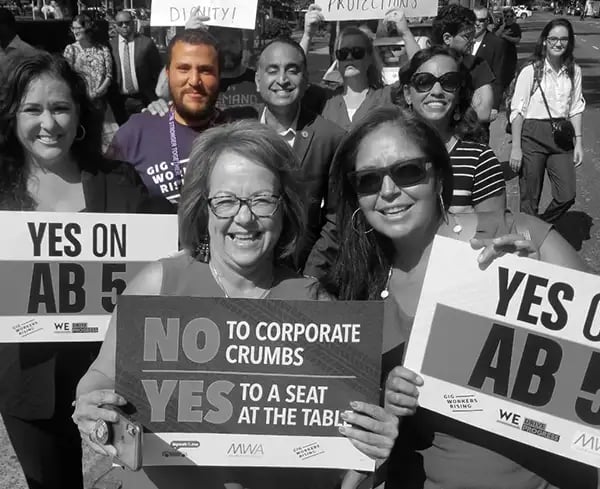
Mostafa Maklad (back center) at a rally in San Francisco (Courtesy of Mostafa Maklad)
Maklad has found a form of respite in activism: He is a proud member of the driver-activist group Gig Workers Rising, a campaign that fights for better wages and working conditions for gig workers.
But for now, his focus is on grinding out 12-hour shifts, so he can continue to pay his bills and support his family in Egypt.
Tomorrow, he’ll be back out on the zig-zag streets of San Francisco, weathering a pandemic that has made rides and income sparse.
“The majority of people are staying home, but we don’t have that luxury,” he says. “Every day, we have to choose between being safe and making a living.”
***
NOTE: Want to give a small ‘tip’ to the drivers in this article? We’ve posted several of their payment handles below, with permission. Anything helps during a rough time.
- Mostafa Maklad: @unnnaamed (Venmo)
- Steve Gregg: @Steve48 (Venmo)
- Yash Bazian: @Ybazian (Venmo)
- Amirali Alex F.: @amiralidrivesalot (Venmo)
- Kimberly James: @Kimberly-James-32 (Venmo)
- Cindy Chavez @cchavezdragon (Venmo)
- Carlos Ramos: paypal.me/carlosincharge (PayPal)
- Virginia Arellano: varellano1981@yahoo.com (PayPal)
- Rosa S.: Paypal.me/rose68 (PayPal)
- Melvin G.: $MeltheThinker (Cash App)

